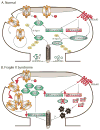Taking STEPs forward to understand fragile X syndrome
- PMID: 22009355
- PMCID: PMC3922766
- DOI: 10.1007/978-3-642-21649-7_12
Taking STEPs forward to understand fragile X syndrome
Abstract
A priority of fragile X syndrome (FXS) research is to determine the molecular mechanisms underlying the functional, behavioral, and structural deficits in humans and in the FXS mouse model. Given that metabotropic glutamate receptor (mGluR) long-term depression (LTD) is exaggerated in FXS mice, considerable effort has focused on proteins that regulate this form of synaptic plasticity. STriatal-Enriched protein tyrosine Phosphatase (STEP) is a brain-specific phosphatase implicated as an "LTD protein" because it mediates AMPA receptor internalization during mGluR LTD. STEP also promotes NMDA receptor endocytosis and inactivates ERK1/2 and Fyn, thereby opposing synaptic strengthening. We hypothesized that dysregulation of STEP may contribute to the pathophysiology of FXS. We review how STEP's expression and activity are regulated by dendritic protein synthesis, ubiquitination, proteolysis, and phosphorylation. We also discuss implications for STEP in FXS and other disorders, including Alzheimer's disease. As highlighted here, pharmacological interventions targeting STEP may prove successful for FXS.
Figures



Similar articles
-
Genetic manipulation of STEP reverses behavioral abnormalities in a fragile X syndrome mouse model.Genes Brain Behav. 2012 Jul;11(5):586-600. doi: 10.1111/j.1601-183X.2012.00781.x. Epub 2012 Apr 6. Genes Brain Behav. 2012. PMID: 22405502 Free PMC article.
-
Dysregulated NMDA-Receptor Signaling Inhibits Long-Term Depression in a Mouse Model of Fragile X Syndrome.J Neurosci. 2016 Sep 21;36(38):9817-27. doi: 10.1523/JNEUROSCI.3038-15.2016. J Neurosci. 2016. PMID: 27656021 Free PMC article.
-
Striatal-enriched Tyrosine Protein Phosphatase (STEP) in the Mechanisms of Depressive Disorders.Curr Protein Pept Sci. 2017 Aug 30;18(11):1152-1162. doi: 10.2174/1389203718666170710121532. Curr Protein Pept Sci. 2017. PMID: 28699511 Review.
-
Metabotropic receptor-dependent long-term depression persists in the absence of protein synthesis in the mouse model of fragile X syndrome.J Neurophysiol. 2006 May;95(5):3291-5. doi: 10.1152/jn.01316.2005. Epub 2006 Feb 1. J Neurophysiol. 2006. PMID: 16452252
-
BDNF in fragile X syndrome.Neuropharmacology. 2014 Jan;76 Pt C:729-36. doi: 10.1016/j.neuropharm.2013.05.018. Epub 2013 May 29. Neuropharmacology. 2014. PMID: 23727436 Review.
Cited by
-
Finding novel distinctions between the sAPPα-mediated anabolic biochemical pathways in Autism Spectrum Disorder and Fragile X Syndrome plasma and brain tissue.Sci Rep. 2016 May 23;6:26052. doi: 10.1038/srep26052. Sci Rep. 2016. PMID: 27212113 Free PMC article.
-
Targeted pharmacological treatment of autism spectrum disorders: fragile X and Rett syndromes.Front Cell Neurosci. 2015 Feb 26;9:55. doi: 10.3389/fncel.2015.00055. eCollection 2015. Front Cell Neurosci. 2015. PMID: 25767435 Free PMC article. Review.
-
The function of metabotropic glutamate receptors in thalamus and cortex.Neuroscientist. 2014 Apr;20(2):136-49. doi: 10.1177/1073858413478490. Epub 2013 Mar 4. Neuroscientist. 2014. PMID: 23459618 Free PMC article. Review.
-
Lens Biology is a Dimension of Neurobiology.Neurochem Res. 2017 Apr;42(4):933-942. doi: 10.1007/s11064-016-2156-x. Epub 2017 Feb 4. Neurochem Res. 2017. PMID: 28161753 Review.
-
Regulation of STEP61 and tyrosine-phosphorylation of NMDA and AMPA receptors during homeostatic synaptic plasticity.Mol Brain. 2015 Sep 22;8(1):55. doi: 10.1186/s13041-015-0148-4. Mol Brain. 2015. PMID: 26391783 Free PMC article.
References
-
- Bear MF, Huber KM, Warren ST. The mGluR theory of fragile X mental retardation. Trends Neurosci. 2004;27:370–377. - PubMed
-
- Besshoh S, Bawa D, Teves L, Wallace MC, Gurd JW. Increased phosphorylation and redistribution of NMDA receptors between synaptic lipid rafts and post-synaptic densities following transient global ischemia in the rat brain. J Neurochem. 2005;93:186–194. - PubMed
-
- Blanpied TA, Scott DB, Ehlers MD. Dynamics and regulation of clathrin coats at specialized endocytic zones of dendrites and spines. Neuron. 2002;36:435–449. - PubMed
Publication types
MeSH terms
Substances
Grants and funding
LinkOut - more resources
Full Text Sources
Medical
Research Materials
Miscellaneous

